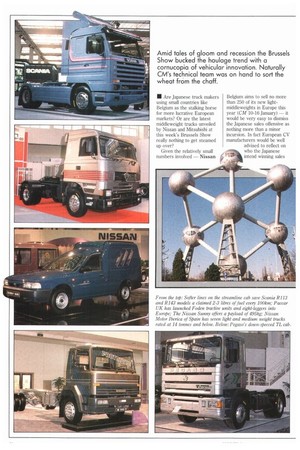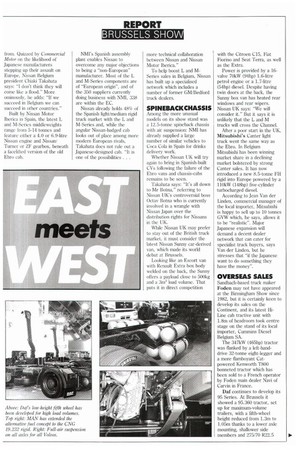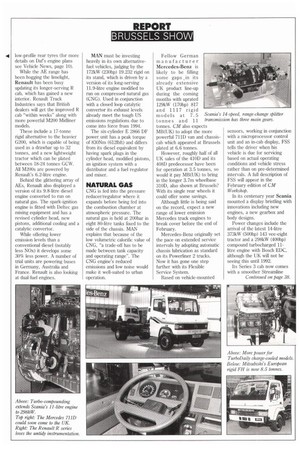Amid tales of gloom and recession the Brussels Show bucked
Page 32

Page 33

Page 34

Page 40

If you've noticed an error in this article please click here to report it so we can fix it.
the haulage trend with a cornucopia of vehicular innovation. Naturally CM's technical team was on hand to sort the wheat from the chaff.
• Are Japanese truck makers using small countries like Belgium as the stalking horse for more lucrative European markets? Or are the latest middleweight trucks unveiled by Nissan and Mitsubishi at this week's Brussels Show really nothing to get steamed up over?
Given the relatively small numbers involved — Nissan Belgium aims to sell no more than 250 of its new lightmiddleweights in Europe this year (CM 10-16 January) — it would be very easy to dismiss the Japanese sales offensive as nothing more than a minor incursion. In fact European CV manufacturers would be well advised to reflect on who the Japanese intend winning sales
from. Quizzed by Commercial Motor on the likelihood of Japanese manufacturers stepping up their assault on Europe, Nissan Belgium president Chiaki Takahata says: "1 don't think they will come like a flood." More ominously, he adds: "If we succeed in Belgium we can succeed in other countries."
Built by Nissan Motor Iberica in Spain, the latest L and M-Series middleweights range from 5-14 tonnes and feature either a 4.0 or 6.9-litre Nissan engine and Nissan/ Turner or ZE gearbox, beneath a facelifted version of the old Ebro cab. NM1's Spanish assembly plant enables Nissan to overcome any major objections to being a "non-European" manufacturer. Most of the L and M-Series components are of "European origin", and of the 350 suppliers currently doing business with NMI, 338 are within the EC.
Nissan already holds 48% of the Spanish light/medium rigid truck market with the L and M-Series and, while the angular Nissan-badged cab looks out of place among more modern European rivals, Takahata does not rule out a Japanese-designed cab. "It is one of the possibilities. . more technical collaboration between Nissan and Nissan Motor Iberic.a."
To help boost L and MSeries sales in Belgium, Nissan has built up a specialised network which includes a number of former GM/Bedford truck dealers.
SPINEBACKCHASSIS
Among the more unusual models on its show stand was a 12.5-tonne spineback chassis with air suspension: NMI has already supplied a large number of similar vehicles to Coca Cola in Spain for drinks delivery work.
Whether Nissan UK will try again to bring in Spanish-built CVs following the failure of the Ebro vans and chassis-cabs remains to be seen.
Takahata says: "it's all down to Mr Botna," referring to Nissan UK's controversial boss Octav Botna who is currently involved in a wrangle with Nissan Japan over the distribution rights for Nissans in the UK.
While Nissan UK may prefer to stay out of the British truck market, it must consider the latest Nissan Sunny car-derived van, which made its world debut at Brussels.
Looking like an Escort van with Renault Extra box body welded on the back, the Sunny offers a payload close to 500kg and a 3rn load volume. That puts it in direct competition with the Citroen C15, Fiat l■iorino and Seat Terra, as well as the Extra.
Power is provided by a 16valve 70kW (94hp) 1.6-litre petrol engine or a 1.7-litre (54hp) diesel. Despite having twin doors at the back, the Sunny box van has heated rear windows and rear wipers. Nissan UK says: "We will consider it." But it says it is unlikely that the L and M trucks will cross the Channel.
After a poor start in the UK, Mitsubishi's Canter light truck went the same way as the Ebro. In Belgium Mitsubishi has been winning market share in a declining market bolstered by strong Canter sales. It has now introduced a new 8.5-tonne FH rigid into Europe powered by a 110kW (148hp) five-cylinder turbocharged diesel.
According to Jean Van der Linden, commercial manager of the local importer, Mitsubishi is happy to sell up to 10 tonnes GVW which, he says, allows it to be "realistic". Major Japanese expansion will demand a decent dealer network that can cater for specialist truck buyers, says Van der Linden, but he stresses that "if the Japanese want to do something they have the money".
OVERSEAS SALES
Sandbach-based truck maker Foden may not have appeared at the Birmingham Show since 1982, but it is certainly keen to develop its sales on the Continent, and its latest fhLine cab tractive unit with 1.8m of headroom took centre stage on the stand of its local importer, Cummins Diesel Belgium SA.
The 347kW (465hp) tractor was flanked by a left-handdrive 32-tonne eight-legger and a more flamboyant Catpowered Kenworth T800 bonneted tractor which has been sold to a French operator by Foden main dealer Navi of Carlin in France.
Daf continues to develop its 95 Series. At Brussels it showed a 95.360 tractor, set up for maximum-volume trailers, with a fifth-wheel height reduced from 1.3m to 1.05m thanks to a lower axle mounting, shallower side members and 275/70 R22.5
low-profile rear tyres (for more details on Dal's engine plans see Vehicle News, page 10).
While the AE range has been hogging the limelight, Renault has been busy updating its longer-serving R cab, which has gained a new interior. Renault Truck Industries says that British dealers will get the improved R cab "within weeks" along with more powerful M200 Midliner models.
These include a 17-tonne rigid alternative to the heavier G200, which is capable of being used as a drawbar up to 32 tonnes, and a new lightweight tractor which can be plated between 18-24 tonnes GCW. All M200s are powered by Renault's 6.2-litre engine.
Behind the glittering array of AEs, Renault also displayed a version of its 9.8-litre diesel engine converted to run on natural gas. The spark-ignition engine is fitted with Deltec gas mixing equipment and has a revised cylinder head, new pistons, additional cooling and a catalytic convertor.
While offering lower emission levels than a conventional diesel (notably less N0x) it develops some 30% less power. A number of trial units are powering buses in Germany, Australia and France. Renault is also looking at dual-fuel engines. MAN must be investing heavily in its own alternativefuel vehicles, judging by the 172kW (230hp) 19.232 rigid on its stand, which is driven by a version of its long-serving 11.9-Litre engine modified to run on compressed natural gas (CNG). Used in conjunction with a closed loop catalytic convertor its exhaust levels already meet the tough US emissions regulations due to come into force from 1994.
The six-cylinder E 2866 DE power unit has a peak torque of 830Nm (612Ib1t) and differs from its diesel equivalent by having spark plugs in the cylinder head, modified pistons, an ignition system with a distributor and a fuel regulator and mixer,
NATURAL GAS
CNG is fed into the pressure reducer/regulator where it expands before being fed into the combustion chamber at atmospheric pressure. The natural gas is held at 200bar in eight 80-litre tanks fixed to the side of the chassis. MAN explains that because of the low volumetric calorific value of CNG, "a trade-off has to be made between tank capacity and operating range". The CNG engine's reduced emissions and low noise would make it well-suited to urban operation. Fellow German manufacturer Mercedes-Benz is likely to be filling some gaps ,in its already extensive UK product line-up during the coming months with uprated 129kW (170hp) 817 and 1117 rigid models at 7.5 Scania's 14-speed, range-change splitter tonnes and 11 transmission has three main gears. tonnes. CM also expects MB(UK) to adopt the more powerful 7111) van and chassiscab which appeared at Brussels plated at 6.6 tonnes.
However, roughly half of all UK sales of the 410D and its 408D predecessor have been for operation at 3_5 tonnes, so would it pay MB(UK) to bring in the longer 3.7m wheelbase 3101), also shown at Brussels? With its single rear wheels it could offer some savings.
Although little is being said on the record, expect a new range of lower emission Mercedes truck engines to break cover before the end of February.
Mercedes-Benz originally set the pace on extended service intervals by adopting automatic chassis lubrication as standard on its Powerliner 2 trucks. Now it has gone one step further with its Flexible Service System.
Based on vehicle-mounted
sensors, working in conjunction with a microprocessor control unit and an in-cab display, FSS tells the driver when his vehicle is due for servicing based on actual operating conditions and vehicle stress rather than OD pre-determined intervals. A full description of FSS will appear in the February edition of CM Workshop.
In its centenary year Scania mounted a display bristling with innovations including new engines, a new gearbox and body designs.
Power changes include the arrival of the latest 14-litre 373kW (500hp) 143 vee-eight tractor and a 298kW (400hp) compound turbocharged 11litre engine with Bosch EDC, although the UK will not be seeing this until 1992.
Its Series 3 cab now comes with a smoother Streamline Continued on page 38.
Continued from page 32. package (CM 6-12 December 1990) which is standard on all Top Line cabs. The Streamline has an air resistance factor of around 0.5 which is up to 15% better than the standard cab and is said to improve fuel economy by up to 5%. Scania has also developed a new 14speed gearbox which is due to reach the UK this year first in the 143.5(X).
MORE POWER
As expected, the long-awaited charge-cooled version of Iveco's torquey little 2.5-litre direct-injection diesel used in the TurboDaily vans and chassis-cabs debuted at Brussels. The latest 8140.47 engine offers 12% more power — 85kW (116hp) — and 9% more torque at 255Nm (1881bft). As well as its chargecooling system, the TurboDaily engine has been treated to new pistons, injectors and special Bosch pump, an optimised • KKK turbocharger and a new gearbox and braking system. The new engine has allowed Iveco Ford to extend its UK TurboDaily line-up. The current turbocharged 49.10 model at five tonnes GVW is augmented by the latest charge-cooled 49.12, available as either a van or a chassiscab. More significantly, there is now a heavier 59.12 version at 5.9 tonnes, also offered as a van or chassis-cab.
With its longer wheelbase and higher roof. the 59.12 van provides a 1711-0 load volume compared with the 15.4nr' of the standard 49.12 van. Payload is up too, thanks to a higher GVW.
The arrival of the heavier TurboDaily will signal a gradual phasing out of the existing TurboZeta integral vans below 7.5 tonnes to avoid any unnecessary product duplication. More important to the UK municipal market is Iveco Ford's plans to launch a crew-cab on the 49.10 and 49.12 TurboDailys.
After displaying a concept unit at the 1989 Frankfurt Show, Iveco is finally offering the Semi Automated Mechanical Transmission (SAMT) version of the Eaton Twin Splitter gearbox as an option in the 190.36 TurboStar, hut it has yet to announce UK availability.
REVISED EQUIPMENT
The fact that Iveco now owns 60% of Pegaso was underlined by the proximity of the Spanish manufacturer to the Italian company's stand.
Pegaso has revised its fourvalves-per-cylinder 12-litre Troner engine which was previously only available at 268kW (360hp). Now there is a 276kW (370hp) version with revised fuel injection equipment offering better noise and emission levels.
More important is the new 253kW (340hp) variant, which is designed to woo the fleet market. The 253kW engine powers the Troner 1234T, which also features the latest 'FL cab — Pegaso's equivalent to the fleet-spec Seddon Atkinson Strato TC cab.
The TL features a simpler bottom bumper spoiler and shorter door panels. It also loses the front quarter panel deflectors. The interior, without detracting from the attractive Troller interior, has a more practical trim.
Pegaso's International division director Roger Dougherty says that "logically with time" the TL ironer could go on sale in the UK, although he says that given the depressed state of the British market this is not the best time for a new product.
Volvo is now offering frontaxle air suspension on its lefthand-drive FL614 chassis; the same system will be offered as a special vehicle order on UKspec FL614s, and probably on FL613/612s too.
CI A full report on the bodywork at Brussels will appear in February's CM Bodybuilder.




































































